26th August, 2025
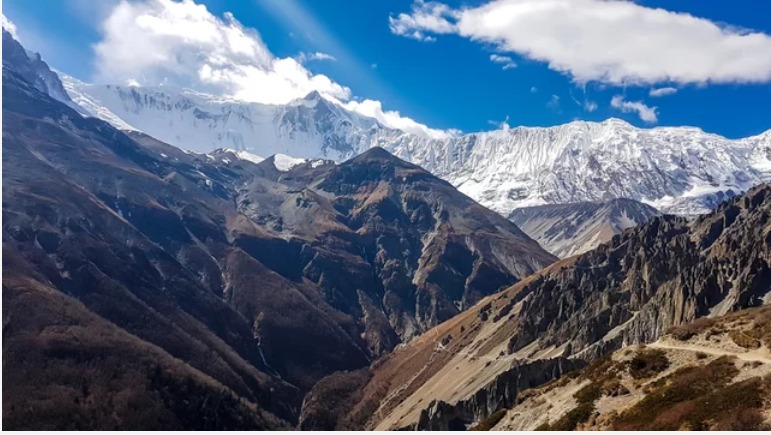
Oct 31, 2023
Annapurna Base Camp Trek In February
- ABC Trek In February Highlights
- Can We Do Annapurna Base Camp Trek Without Guide?
- Can I Trek to ABC Solo?
- How Can I Get to Annapurna Base Camp?
- Can I Do It In 7 Days?
- What Should I Pack For February Trek to ABC?
- What Kind of Permit Required for ABC?
- What Should I Pack for ABC Trek In February?
- Weather and Climate Conditions
- Route Options and Itinerary Planning
- Preparation and Packing Guide
- Safety Tips and Considerations
- Altitude Sickness Awareness
- Flora and Fauna Along the Trail
- Photography Tips
- Challenges of Trekking in February
- Permits and Regulations
- Benefits of Trekking in February
- Conclusion
- Annapurna Base Camp Trekking packages
Trekking to Annapurna Base Camp (ABC) in February offers a unique and challenging adventure amidst Nepal's winter landscape. February is characterized by cold temperatures and occasional snowfall, creating a picturesque setting along the trekking route. The trail starts from Nayapul or Phedi, accessible from Pokhara, and follows a well-marked path through diverse terrain including lush forests, traditional villages, and alpine meadows.
While February is not the peak trekking season due to colder conditions, it offers solitude and tranquility on the trail with fewer trekkers. The trek to ABC typically takes around 10 to 12 days, allowing for gradual acclimatization to the high altitude. Trekkers are rewarded with stunning views of the Annapurna massif, including peaks like Machapuchare, against the backdrop of clear winter skies.
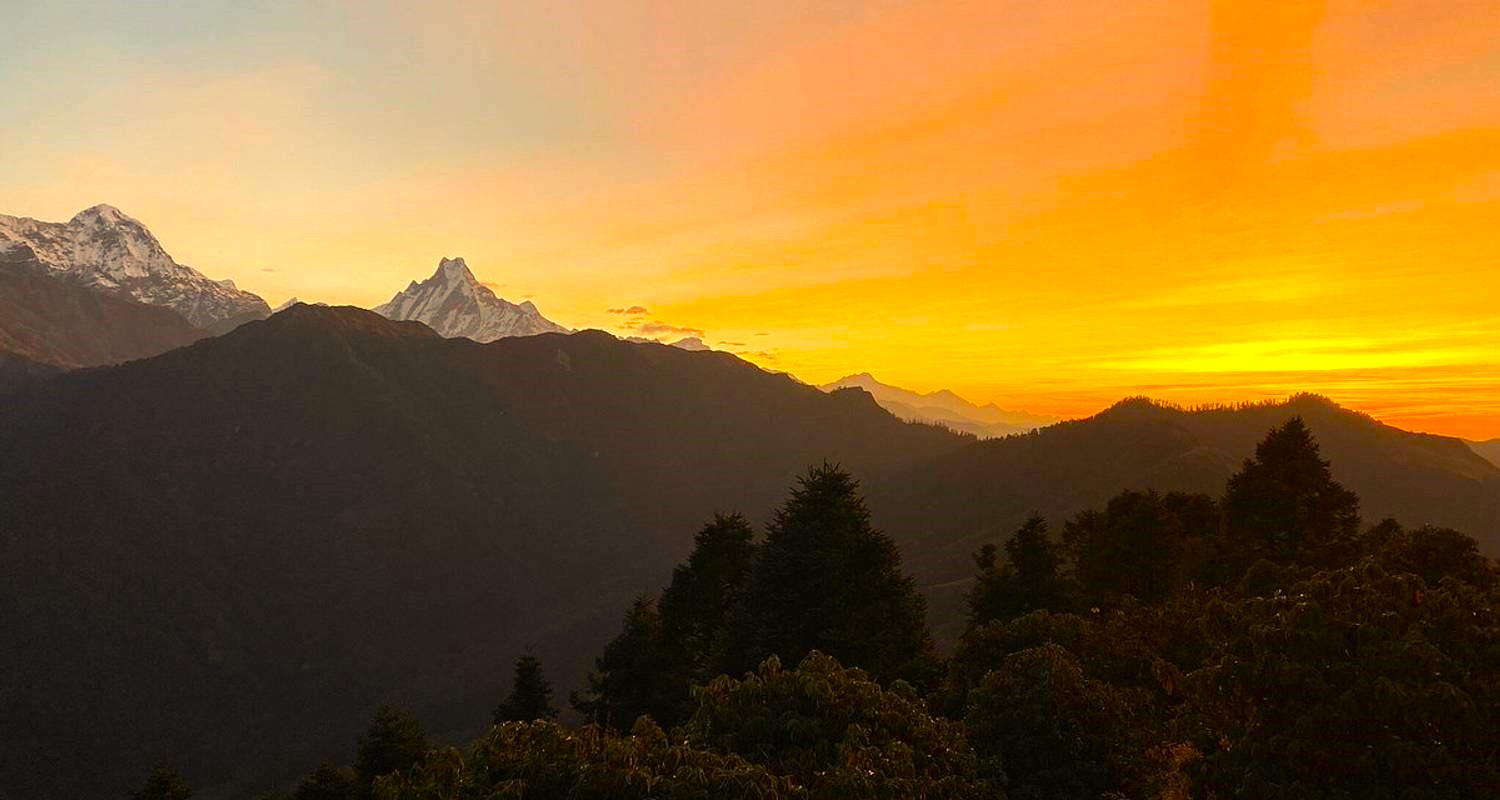
KHOPRA DANDA TREK 6 DAYS
The Khopra Ridge Khayer Lake trek is one of least explored trekking regions in Nepal. It is located to the south of the Annapurna Ranges and is often compared with the Ghorepani Poon Hill trek. Mt. Kh...
Accommodation along the trail is provided by teahouses offering basic amenities such as meals and lodging, making it accessible for trekkers of various experience levels. It's essential for trekkers to pack appropriately for the cold weather, including thermal layers, insulated jackets, waterproof outerwear, gloves, hats, and warm socks. Proper footwear with good traction is crucial for navigating potentially icy or snowy trails.
Cultural interactions with local communities, such as the Gurung and Magar people, provide insights into their traditional lifestyles amidst the winter season. Trekkers should obtain necessary permits, including the Annapurna Conservation Area Permit (ACAP) and TIMS card (Trekkers' Information Management System), before starting the trek.
Overall, trekking to Annapurna Base Camp in February promises a memorable adventure for those seeking stunning Himalayan scenery, cultural experiences, and a challenging yet rewarding trekking experience in Nepal's iconic mountain region.
ABC Trek In February Highlights
Trekking to Annapurna Base Camp (ABC) in February offers a unique adventure amidst Nepal's winter landscape. The trail is typically quieter, providing a serene experience amidst snow-covered forests and pristine mountain vistas. February marks the end of winter, with clear skies and occasional snowfall adding to the scenic beauty along the trekking route. Trekkers can enjoy breathtaking views of the Annapurna range, including peaks like Machapuchare, against the backdrop of crisp winter air. Cultural encounters with local communities, such as the Gurung and Magar people, offer insights into their traditional lifestyles amidst the winter season.

ANNAPURNA BASE CAMP TREK
The Annapurna Base Camp (ABC) Trek via Ghorepani Poon Hill Trek offers a truly unforgettable Himalayan adventure, combining stunning panoramic views with the rich cultural tapestry of the region. This...
Can We Do Annapurna Base Camp Trek Without Guide?
Trekking to Annapurna Base Camp without a guide is possible for experienced trekkers who are confident in their navigation skills and preparedness for the challenges of high-altitude trekking. The trail is well-marked, and teahouses along the route provide accommodation and meals. However, solo trekkers should be well-prepared with a detailed map, GPS device, and knowledge of the route. It's essential to carry necessary permits and have emergency contacts in case of unforeseen circumstances.
Can I Trek to ABC Solo?
Trekking solo to Annapurna Base Camp is feasible for experienced trekkers who are physically fit and have prior trekking experience in similar terrain. Solo trekkers should be prepared for the cold weather conditions in February, with appropriate cold-weather gear including insulated clothing, waterproof layers, gloves, and a warm sleeping bag suitable for sub-zero temperatures. It's crucial to inform someone about your itinerary, carry necessary permits, and be aware of potential altitude-related issues. While solo trekking offers independence, hiring a guide or joining a trekking group can enhance safety and provide local insights.

GHOREPANI POON HILL ABC TREK
This is a classic trek, visiting Ghorepani (2874m), Poon Hill (3210m) & Annapurna Base Camp (4130m) - all within the Annapurna Conservation Area.Annapurna is a Sanskrit name which literally means...
How Can I Get to Annapurna Base Camp?
The trek to Annapurna Base Camp typically starts from Nayapul or Phedi, accessible from Pokhara by road. From Pokhara, a scenic 1.5 to 2-hour drive takes you to the trek's starting point. Alternatively, trekkers can take a short flight from Kathmandu to Pokhara and then proceed by road to the trailhead. The trek itself follows a well-established route through picturesque villages, dense forests, and alpine meadows, eventually reaching the spectacular amphitheater of Annapurna Base Camp. Teahouses and lodges along the trail provide accommodation and meals, making it accessible for trekkers of varying experience levels and preferences.
Can I Do It In 7 Days?
While it's possible to complete the Annapurna Base Camp trek in 7 days, it is a challenging itinerary that requires good physical fitness and acclimatization. The standard trekking duration is usually 10 to 12 days, allowing for gradual ascent and acclimatization to the high altitude. A 7-day itinerary typically involves trekking long hours each day, which may not be suitable for everyone, especially considering the altitude gains and potential for altitude sickness. Trekkers opting for a 7-day trek should be prepared for strenuous hiking, early starts, and limited acclimatization time, which increases the risk of altitude-related issues. It's essential to listen to your body, stay hydrated, and be aware of symptoms of altitude sickness. Consideration should also be given to weather conditions and the availability of transportation to and from the trek's starting point, which may impact the feasibility of a shorter itinerary.
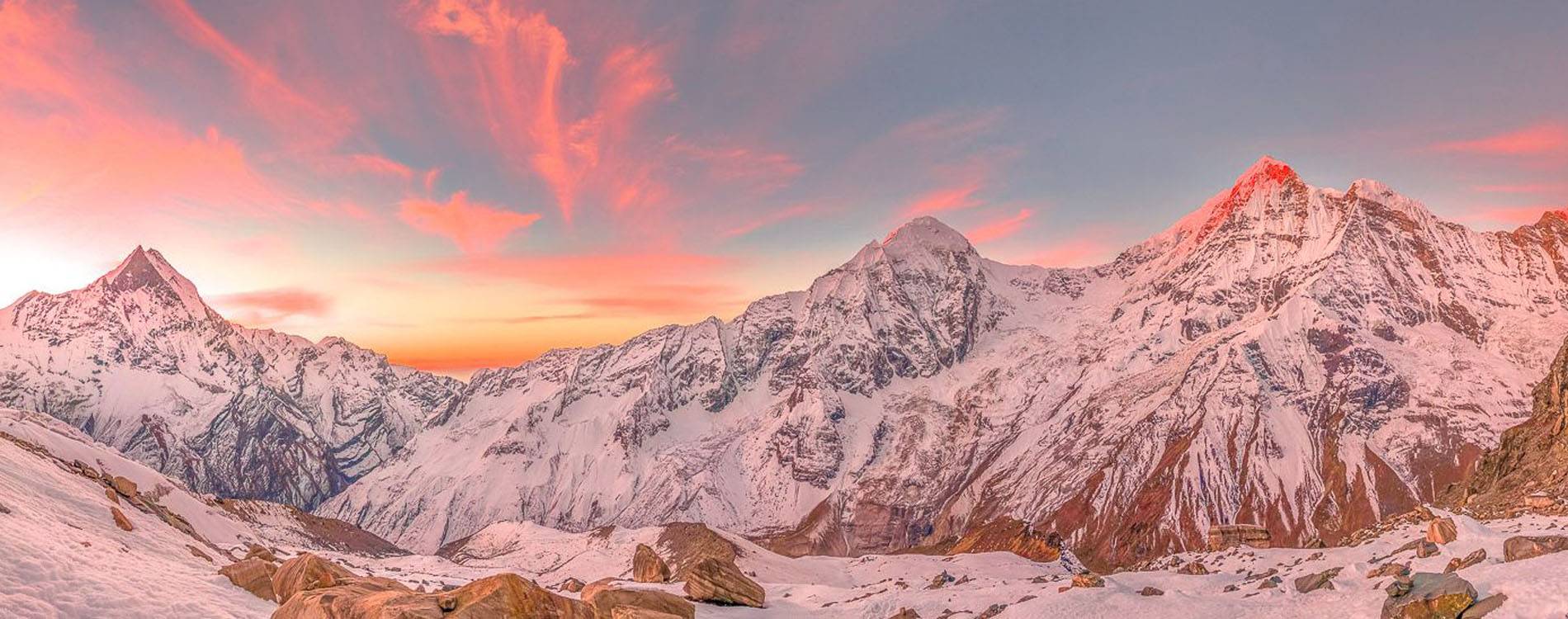
7 DAYS ANNAPURNA BASE CAMP TREK
Short on time – big on beauty!The 7 days Annapurna Base Camp Trek takes you to all the major attractions – but in less time than other treks to the Annapurna region. Take in the spectacular soaring sn...
What Should I Pack For February Trek to ABC?
Packing for a February trek to Annapurna Base Camp requires careful consideration of the cold weather and potential snowfall along the trail. Essential items include:
- Clothing: Thermal base layers, insulated jacket, waterproof and windproof outer layers, fleece or down jacket, gloves, hat, and warm socks.
- Footwear: Sturdy waterproof hiking boots with good traction, gaiters (for snow and mud), and comfortable trekking socks.
- Gear: Sleeping bag suitable for sub-zero temperatures, trekking poles, headlamp or flashlight with extra batteries, and a daypack.
- Personal Items: Sunscreen, lip balm, sunglasses, toiletries, and personal medication kit.
- Miscellaneous: Water purification tablets or filter, snacks, camera with extra batteries, and a portable charger.
Pack light but ensure you have essential items for warmth, comfort, and safety throughout the trek. Layers are crucial for adjusting to changing temperatures and weather conditions along the trail.
What Kind of Permit Required for ABC?
To trek to Annapurna Base Camp, trekkers need two permits:
- Annapurna Conservation Area Permit (ACAP): This permit is mandatory for all trekkers entering the Annapurna Conservation Area. It helps fund conservation efforts and costs approximately USD 30.
- TIMS Card (Trekkers' Information Management System): The TIMS card is required to ensure the safety and security of trekkers in the region. It costs around USD 20 for individual trekkers.
Permits can be obtained from the Nepal Tourism Board office in Kathmandu or Pokhara. It's advisable to carry these permits throughout the trek and present them at checkpoints when required.
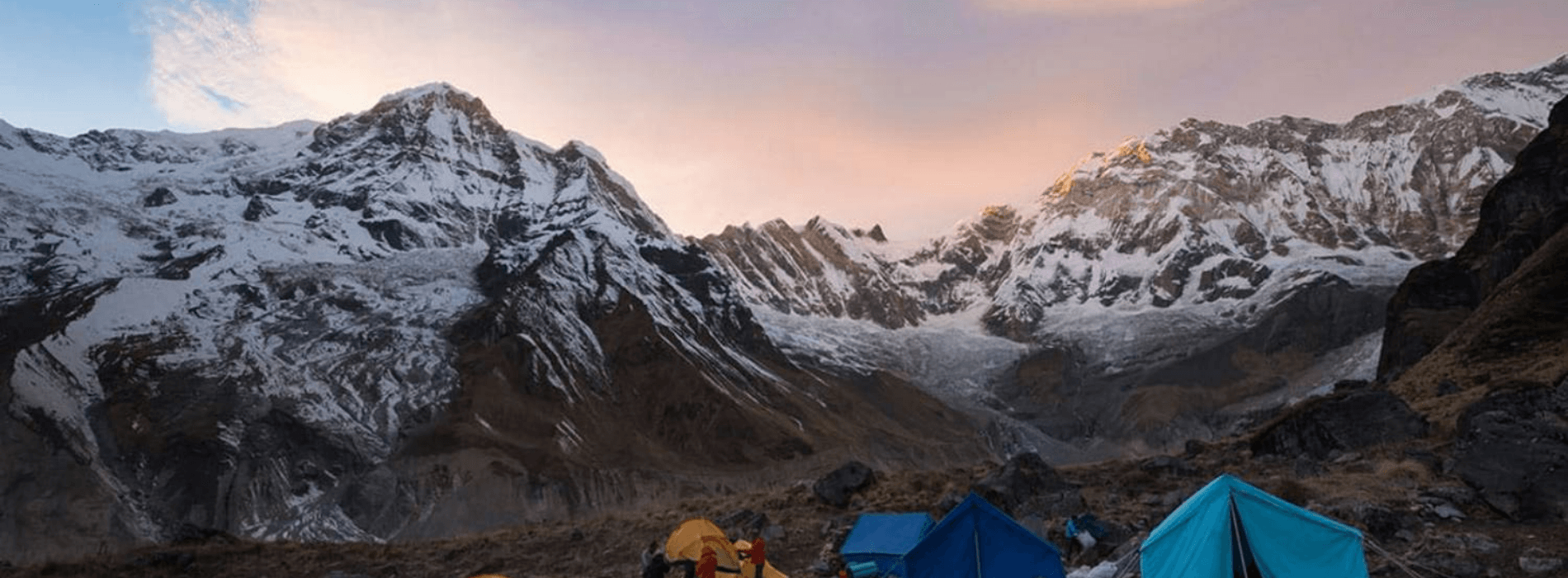
ANNAPURNA BASE CAMP TREK 6 DAYS
The 6 days Annapurna Base Camp Trek is an ideal adventure for those people who have a tight schedule but still want to experience the amazing landscape and the fascinating lifestyles of the Gurung cul...
What Should I Pack for ABC Trek In February?
Packing for the Annapurna Base Camp trek in February requires careful consideration of the cold weather and potential snowfall along the trail. Essential items include:
- Clothing: Thermal base layers, insulated jacket, waterproof and windproof outer layers, fleece or down jacket, gloves, hat, and warm socks.
- Footwear: Sturdy waterproof hiking boots with good traction, gaiters (for snow and mud), and comfortable trekking socks.
- Gear: Sleeping bag suitable for sub-zero temperatures, trekking poles, headlamp or flashlight with extra batteries, and a daypack.
- Personal Items: Sunscreen, lip balm, sunglasses, toiletries, and personal medication kit.
- Miscellaneous: Water purification tablets or filter, snacks, camera with extra batteries, and a portable charger.
Pack light but ensure you have essential items for warmth, comfort, and safety throughout the trek. Layers are crucial for adjusting to changing temperatures and weather conditions along the trail.
Weather and Climate Conditions
Trekking to Annapurna Base Camp in February presents trekkers with cold temperatures and the possibility of snowfall. Daytime temperatures at lower altitudes can range from 5 to 10°C (41 to 50°F), while at higher altitudes, temperatures can drop significantly below freezing, especially at night. It's essential to pack appropriate cold-weather gear such as thermal base layers, insulated jackets, waterproof outerwear, gloves, hats, and warm socks. Layering clothing allows for adjustment to changing weather conditions throughout the day. Despite the cold, February offers clear skies and stunning views of snow-covered peaks, enhancing the scenic beauty of the trek.
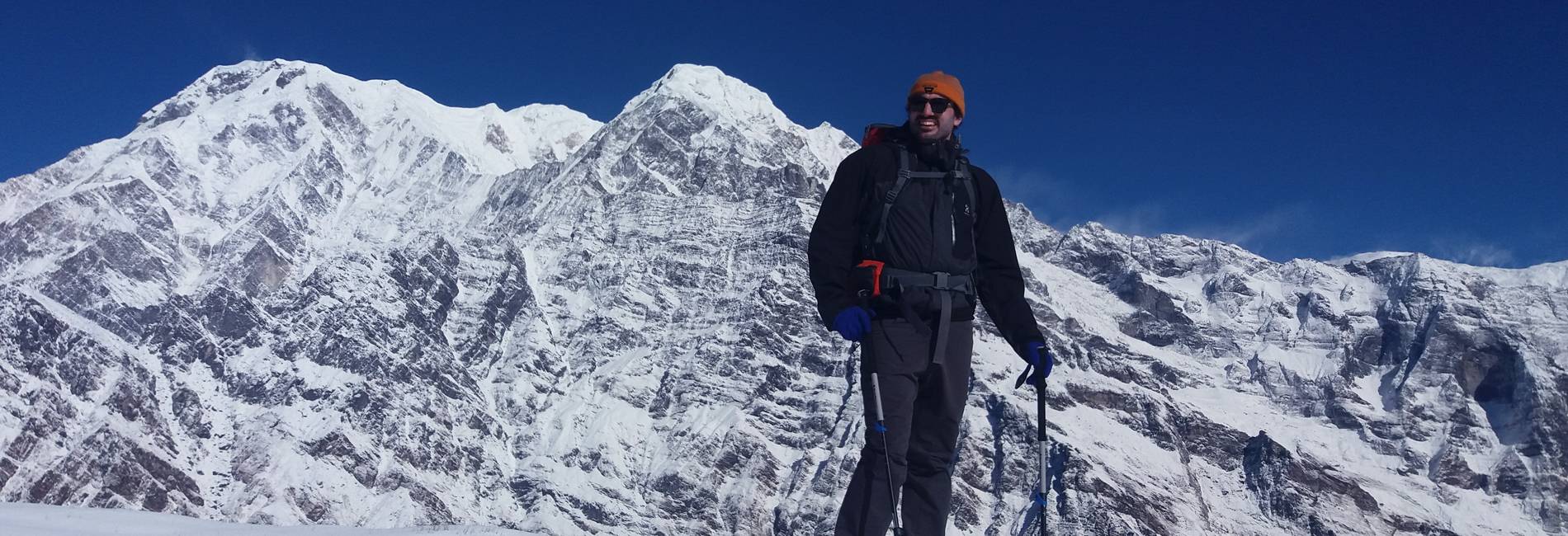
MARDI HIMAL TREK
Enjoy the feeling of solitude as you trek in this remote less traveled region.Fewer tourists, but big on beauty! Snowcapped peaks abound as you enjoy this off-the-beaten-path trek that is full of...
Route Options and Itinerary Planning
Choosing the right route and planning your itinerary for the Annapurna Base Camp trek in February is crucial for a safe and enjoyable experience. Popular routes include starting from Nayapul or Phedi and passing through villages like Chhomrong and Bamboo before reaching ABC. Trekkers typically spend around 10 to 12 days on the trek, allowing for gradual acclimatization to the altitude. It's advisable to check current trail conditions and weather forecasts before embarking on the trek. Flexibility in your itinerary is essential to accommodate potential delays due to weather or personal acclimatization needs. Teahouses along the route provide basic accommodation and meals, making it accessible for trekkers of varying experience levels. Hiring a local guide can offer insights into the local culture, ensure safety, and assist with navigation, especially in winter conditions.
Preparation and Packing Guide
Preparing for the Annapurna Base Camp trek in February requires careful consideration of cold weather conditions and high altitudes. Essential items include thermal base layers, insulated jacket, waterproof and windproof outer layers, fleece or down jacket, gloves, hats, and warm socks. Proper footwear with good traction is crucial for navigating potentially icy or snowy trails. Other necessary gear includes a sleeping bag suitable for sub-zero temperatures, trekking poles, headlamp or flashlight with extra batteries, and a daypack. Personal items such as sunscreen, lip balm, sunglasses, toiletries, and a personal medication kit should also be included. Packing light but efficiently ensures comfort and safety throughout the trek, allowing trekkers to enjoy the stunning winter landscapes of the Annapurna region.
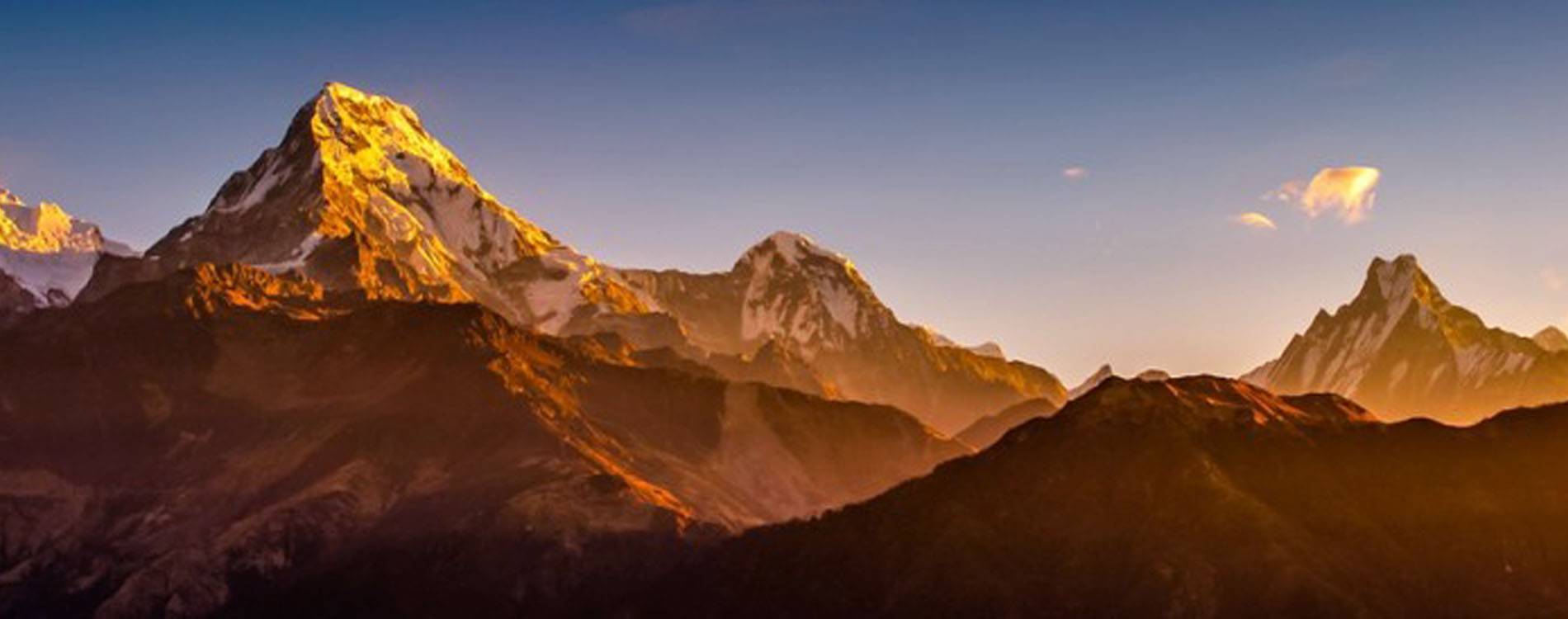
12 DAYS ANNAPURNA BASE CAMP TREK
DOUBLE THE ADVENTURE IN JUST 12 DAYS! The 12 Day Annapurna Base Camp Trek combines two well-known and popular treks into one - the Ghorepani Poon Hill Trek and the Annapurna Base Camp Trek (ABC)....
Safety Tips and Considerations
Trekking to Annapurna Base Camp in February requires careful attention to safety due to cold weather conditions and high altitudes. Ensure you have adequate cold-weather gear and dress in layers to stay warm and dry. Stay hydrated by drinking plenty of fluids and avoid overexertion, especially in the early stages of the trek to prevent altitude sickness. Acclimatize gradually by following recommended altitude gain guidelines and be aware of symptoms of altitude sickness such as headache, nausea, and dizziness. Carry a first aid kit and emergency contacts, and inform someone about your itinerary before starting the trek. Follow local guidelines and respect the environment and culture of the region. In winter conditions, be cautious of icy or slippery trails and be prepared for unexpected changes in weather.
Altitude Sickness Awareness
Altitude sickness, or acute mountain sickness (AMS), can affect trekkers ascending to higher altitudes, including those trekking to Annapurna Base Camp in February. Symptoms may include headache, nausea, fatigue, dizziness, and difficulty sleeping. It's caused by reduced oxygen levels at higher altitudes and can affect anyone regardless of age or fitness level. To prevent altitude sickness, ascend gradually, allowing time for acclimatization. Stay hydrated, avoid alcohol and smoking, and eat light meals rich in carbohydrates. If symptoms of altitude sickness occur, rest at the same altitude or descend to a lower elevation until symptoms improve. Medications like acetazolamide (Diamox) can help prevent and treat altitude sickness but should be used under medical supervision. Awareness of altitude sickness and proper acclimatization practices are essential for a safe and enjoyable trekking experience to Annapurna Base Camp in February.
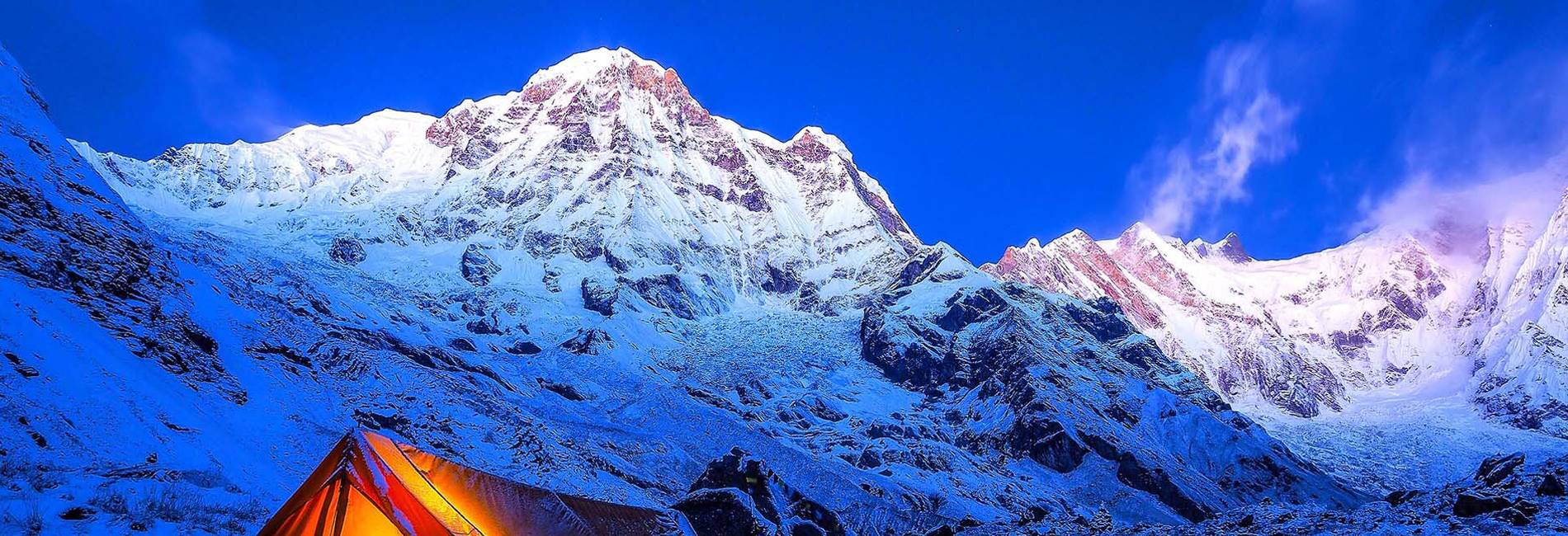
13 DAYS ANNAPURNA BASE CAMP TREK
Discover why “The Annapurna Base Camp (ABC) trek is world-famous. Here is a sample of soaring snow-capped peaks you will see along the trail: Mt. Dhaulagiri (8167m), Mt. Annapurna I (8091m) Mt. M...
Flora and Fauna Along the Trail
Trekking to Annapurna Base Camp in February offers a unique opportunity to encounter diverse flora and fauna amidst the winter landscape. At lower elevations, the trail passes through lush forests of rhododendron, oak, and bamboo, which may be dusted with snow during this time of year, creating a picturesque scenery. As trekkers ascend towards higher altitudes, the vegetation transitions to alpine meadows and barren landscapes, showcasing hardy plants adapted to cold climates.
Wildlife sightings along the trail include Himalayan tahr, musk deer, and various species of birds such as Himalayan Monal and Snow Pigeon. While wildlife activity may be less visible during winter months, the serene environment and occasional encounters with these creatures add to the trekking experience.
Photography Tips
Photographing the Annapurna Base Camp trek in February requires preparation for capturing the stark beauty of winter landscapes and mountain vistas. Here are some tips to enhance your photography experience:
- Early Mornings and Late Afternoons: The soft light during these times enhances the texture and colors of the snowy terrain. Capture sunrise and sunset for dramatic shots.
- Use of Reflections: Snow-covered surfaces can act as natural reflectors, enhancing the brightness and clarity of your images.
- Composition: Incorporate elements like snowy peaks, frozen lakes, and local architecture to add context and interest to your photos.
- Protect Your Gear: Cold temperatures can drain camera batteries quickly. Keep spare batteries warm by storing them close to your body. Use a lens hood to prevent snowflakes from landing on your lens.
- Capture Local Culture: Include portraits of local villagers or scenes of daily life in mountain villages to add a human element to your photographic story.
With these tips, you can capture memorable moments and stunning landscapes during your trek to Annapurna Base Camp in February.
Challenges of Trekking in February
Trekking to Annapurna Base Camp in February presents several challenges that trekkers should be prepared for. The main challenges include:
- Cold Weather: Temperatures can drop significantly, especially at higher altitudes. Proper cold-weather gear is essential to stay warm and comfortable throughout the trek.
- Snowfall: February can experience occasional snowfall along the trail, which may affect visibility and trail conditions. Trekkers should be cautious of slippery and icy paths.
- Accommodation Availability: While the trail is quieter in February, some teahouses along the route may be closed or have limited facilities due to the off-peak season.
- Altitude: The trek involves significant altitude gain, which requires proper acclimatization to prevent altitude sickness.
Despite these challenges, trekking in February offers solitude, stunning winter landscapes, and a unique experience amidst the Annapurna range.
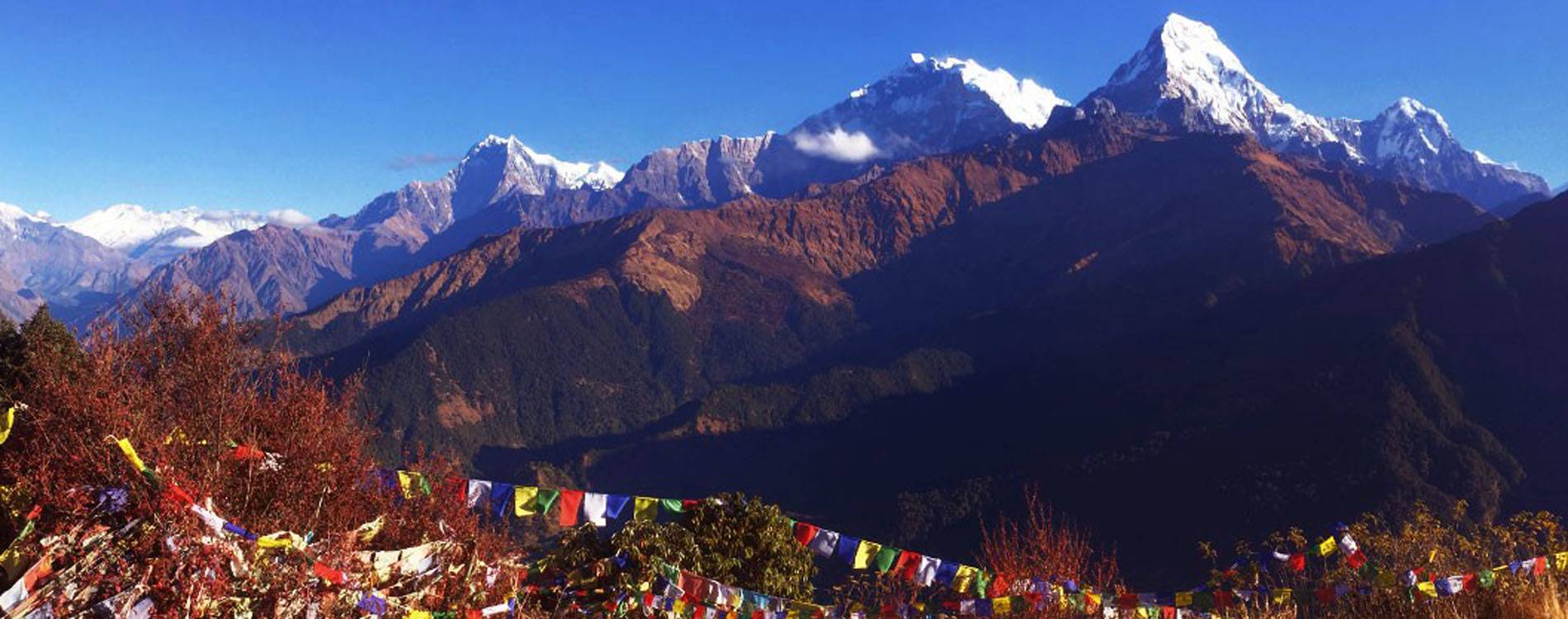
7 DAYS GHOREPANI POON HILL TREK
“THIS IS ONE TREK NOT TO BE MISSED!”A MIND-BLOWING HEAVEN ON-EARTH EXPERIENCE THAT WILL TAKE YOUR BREATH AWAY! SOARING MAJEST...
Permits and Regulations
To trek to Annapurna Base Camp in February, trekkers need to obtain two permits:
- Annapurna Conservation Area Permit (ACAP): This permit is required for all trekkers entering the Annapurna Conservation Area. It helps fund conservation efforts and costs approximately USD 30.
- TIMS Card (Trekkers' Information Management System): The TIMS card is essential for ensuring the safety and security of trekkers in the region. It costs around USD 20 for individual trekkers.
Permits can be obtained from the Nepal Tourism Board office in Kathmandu or Pokhara. It's essential to carry these permits throughout the trek and present them at checkpoints when required.
Benefits of Trekking in February
Trekking to Annapurna Base Camp in February offers several advantages for adventurous travelers:
- Quieter Trails: February is considered the off-peak season, meaning fewer trekkers on the trail. Enjoy more solitude and tranquility amidst the pristine mountain environment.
- Clear Skies: February often features clear skies with excellent visibility, offering stunning views of the snow-capped peaks of the Annapurna range.
- Photographic Opportunities: The winter landscapes, snow-covered mountains, and serene surroundings provide ample opportunities for photography enthusiasts.
- Cultural Interaction: Experience authentic encounters with local communities without the crowds, gaining insights into their traditional lifestyles and customs.
- Affordable: Off-peak season means lower costs for accommodation and fewer crowds, making it a more budget-friendly time to trek.
Overall, trekking to Annapurna Base Camp in February combines natural beauty, cultural experiences, and a sense of adventure, making it a rewarding choice for those seeking a unique Himalayan trekking experience.
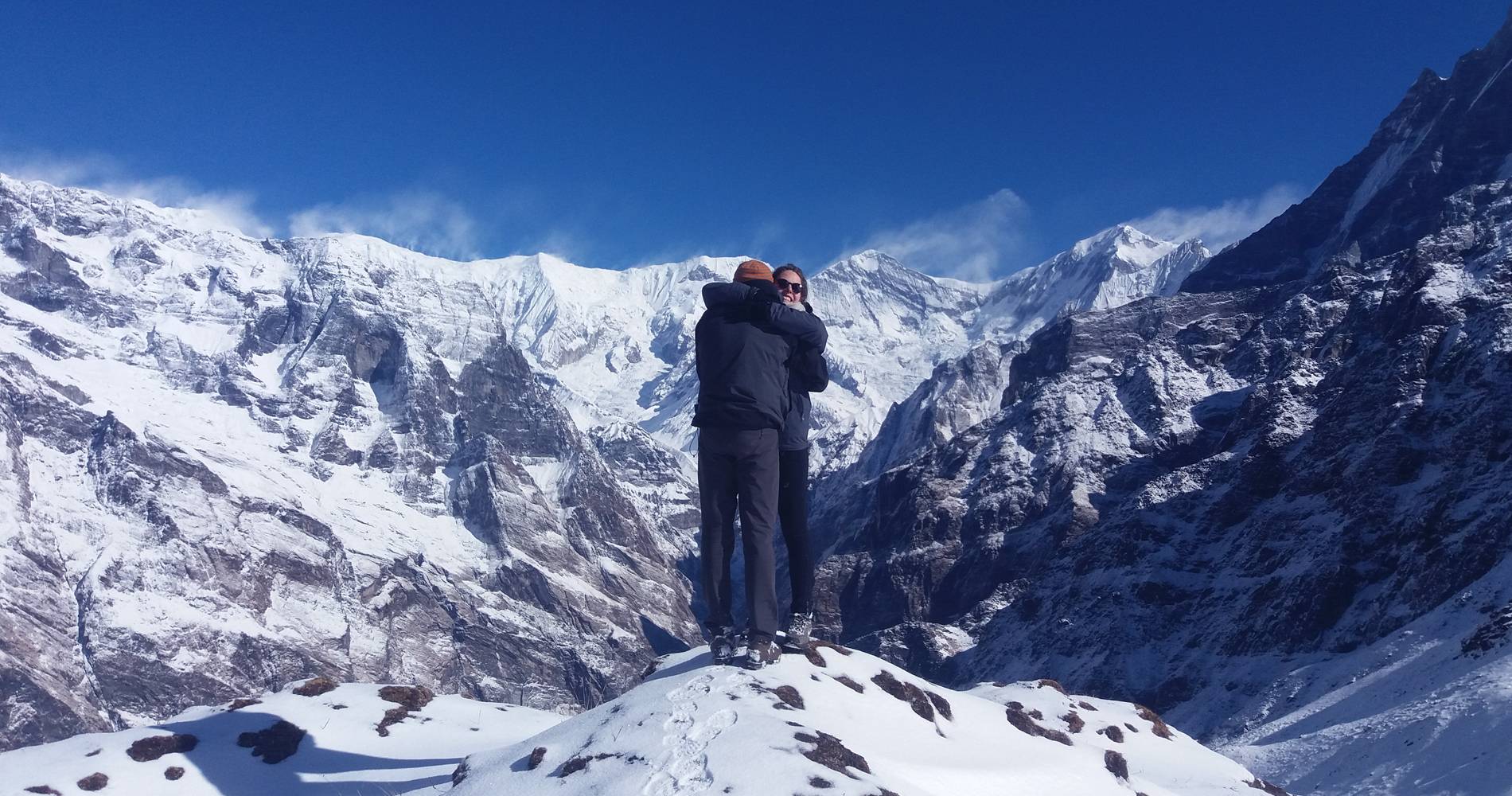
MARDI HIMAL TREK 7 DAYS
Are you seeking a less travelled route into the famous Himalayan Mountains? This is the perfect trek taking you through lush valleys, high altitude alpine meadows, lichen-laden dense forests, across m...
Conclusion
Trekking to Annapurna Base Camp in February is a challenging yet rewarding adventure that offers unique experiences amidst Nepal's winter landscape. The trek presents trekkers with stunning snow-covered peaks, serene trails, and cultural interactions with local communities. Despite the cold temperatures and occasional snowfall, February provides clear skies and quieter trails, allowing for a more intimate experience with nature.
Throughout the trek, trekkers encounter diverse flora and fauna, from rhododendron forests to Himalayan wildlife, adding to the trek's allure. Photography enthusiasts can capture breathtaking winter landscapes, creating lasting memories of their journey to ABC.
Safety and preparation are crucial considerations due to the cold weather and high altitudes. Proper gear, acclimatization, and awareness of altitude sickness symptoms are essential for a safe trekking experience. Trekkers should obtain necessary permits and adhere to regulations to ensure environmental conservation and respect local communities.
In conclusion, trekking to Annapurna Base Camp in February offers solitude, natural beauty, and cultural immersion, making it a memorable adventure for trekkers seeking a quieter Himalayan experience. Whether marveling at snow-capped peaks or forging connections with local villagers, the trek provides a profound appreciation for Nepal's majestic mountains and diverse landscapes.
Annapurna Base Camp Trekking packages
14 Days Annapurna Base Camp Trek
13 Days Annapurna Base Camp Trek
12 Days Annapurna Base Camp Trek
9 Days Annapurna Base Camp Trek
7 Days Annapurna Base Camp Trek
6 Days Annapurna Base Camp Trek
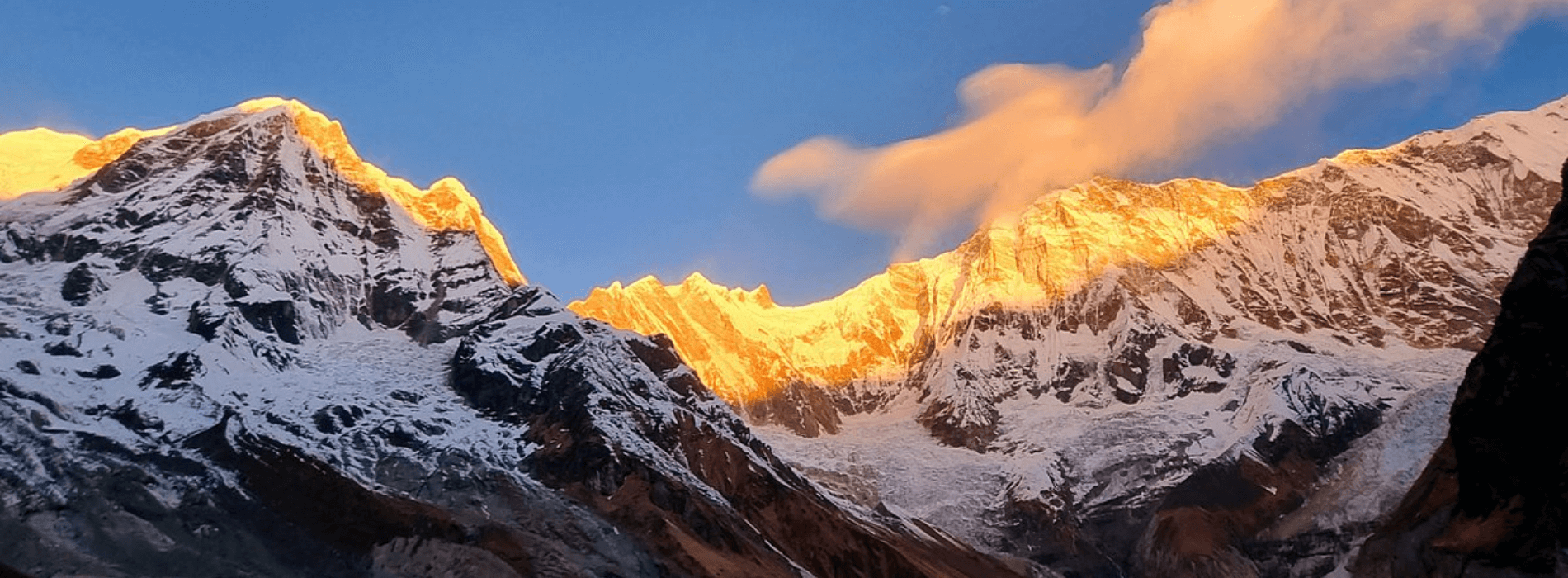
ANNAPURNA BASE CAMP TREK 10 DAYS
This 10 days Annapurna Base Camp (ABC) trek brings you into the heart of Nepal's Himalayas from the very being of the hike. With so many snow-capped peaks on the show, it is no surprise this one-week-...
Any Questions? Let Us Know.
Recent Posts
17th June, 2025


















